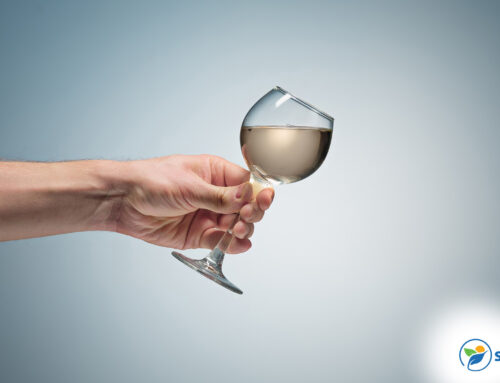People who drink are generally familiar with hangovers. The thick head, pain behind the eyes and general sluggishness is a common side effect of drinking, especially heavy or binge drinking. This unpleasant phenomenon isn’t universal, and it seems between 3% and 23% of the population is hangover-resistant. Just as some people are less likely to get hangovers, some people are more prone to them. There are also certain factors that can increase your risk of getting a hangover, as you know if you’ve ever seen a congeners alcohol chart.
What Are Congeners?
Congeners are the byproducts that get made at the same time as the alcohol you’re drinking. When brewers ferment yeast, the ethyl alcohol they’re trying to get is accompanied by several other chemicals, many of which are implicated in hangovers. These fermentation products include:
- Acids
- Isobutylene alcohol
- Acetaldehyde, a highly toxic breakdown product of ethyl alcohol
- Esters
- Ketones
This isn’t an exhaustive list of the congeners in wine, beer and other fermented drinks. The chemistry of alcohol production gets complicated fast, but these are some of the most common congeners in drinks. Depending on what you’re drinking and how concentrated these congeners are, you could be setting yourself up for no hangover, a mild hangover or something so serious you might not make it to work the next day.
How Do Congeners Affect Hangovers?
To understand how drinks high in congeners influence hangovers, you have to know something about how a hangover starts and how your body breaks down alcohol. When you take a drink of alcohol, you’re introducing a moderately toxic substance to your system. Almost as soon as the alcohol hits your bloodstream, your liver starts producing enzymes to break down the molecules into something you can metabolize. This is a complex process that takes many hours, and there are a lot of intermediate steps that produce some pretty unpleasant byproducts.
Acetaldehyde, for example, is one of the products your liver breaks alcohol into during the metabolic process of digestion. This is a much more toxic compound than ethyl alcohol itself, and you can only have so much of it in your system before you develop the symptoms of poisoning. In fact, the unexpected buildup of acetaldehyde is implicated as a major factor in alcohol poisoning deaths. In time, your liver will scrub these byproducts out and convert them into sugars you can absorb, but if the process goes wrong anywhere, you could be in for a major hangover.
Some congeners do what they do by directly interfering with the efficient processing of alcohol. Others, such as acetaldehyde, crowd into the process and put a heavier burden on the liver than it can handle. Some others, such as citric acid and tannins in red wine, cause many of the symptoms of a hangover themselves and tend to make things worse for people detoxing after a bout of heavy drinking.
Congeners in Different Alcoholic Drinks
As a rule, the more distilled your drink is, the fewer congeners are going to be in it. This isn’t an endorsement of drinking more concentrated alcohol, but highly distilled liquors tend to have fewer of the extra byproducts that make hangovers worse. To understand why this is, it helps to take a look at how distilled drinks differ from brewed beverages.
Most alcoholic drinks begin as a mash, or some kind of liquefied organic broth that has yeast added to it. This can be brewers’ yeast or a few other varieties, but the important thing is that the yeast sample is alive and able to grow in the mash. Yeast secretes ethyl alcohol as a waste product, which has the effect of killing harmful bacteria and mold, which in turn protects the yeast while it grows. There are limits to how high the alcohol concentration can get, since above 6% or so, alcohol becomes toxic even to the yeast.
Wine and beer usually stop here, but liquor needs to go a step further to get the high concentrations of alcohol that will push it to 80, 90 or 100 proof. To get this, the mash is gently warmed in a still until the alcohol, which has a lower vapor point than water, boils out and rises as steam into a cooling coil. What comes out of this is nearly pure ethyl alcohol, plus a few congeners. More congeners might get added in during the final processing, when vodka, rum, whiskey and other hard liquors get their distinctive flavors.
There’s a lot of variation in alcoholic drinks, even those with the same distilled spirits. In general, the darker a drink looks in the light, the more congeners it’s likely to have in it. Dark drinks high in congeners would be:
- Red wine
- Dark beer
- Cognac
- Whiskey
- Tequila
Lighter drinks are not entirely free from congeners, but they tend to contain less. In this category are:
- White wine
- Light beer and ale
- Gin
- Light rum
- Vodka
- Sake
There’s still a lot more going on that causes and worsens a hangover, but the light/dark distinction is a decent place to start. This is especially true if you’ve already had a few drinks, you’re in a club or at a party and you’re trying to gauge your hangover risk under less-than-optimal conditions.
Factors Affecting Your Own Sensitivity
Your own physiology has a major influence on your hangover risk. Some people are just naturally prone to getting hangovers, while others are likely to have worse or more severe hangovers. Some of this is hereditary, though it’s also possible to build up a tolerance to alcohol over years of drinking. Other ways to limit your hangover risk include drinking less, spacing out your drinks, taking a drink of water between alcoholic beverages and consuming alcohol with food.
Managing the Effects of Hangovers
Even if you’re doing everything right, you can still get a hangover from drinking, especially if you drink too much. If you find yourself frequently dealing with hangovers, you might be drinking more than is healthy for you. If you or someone you care for needs help with problem drinking, you can reach out to the compassionate professionals at Sunlight Recovery to get advice and confidential referrals for care.






